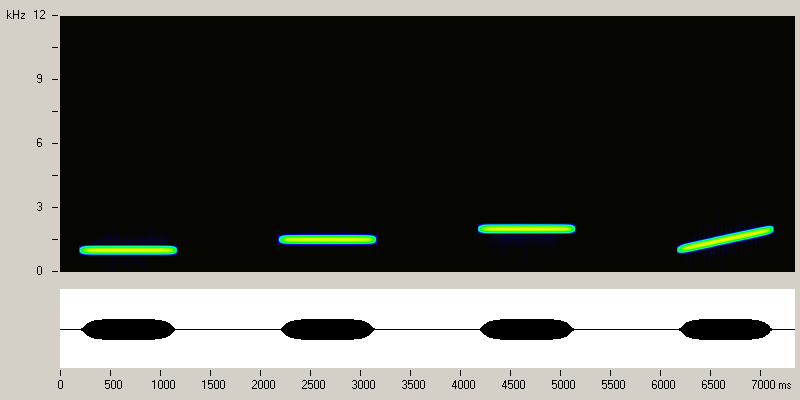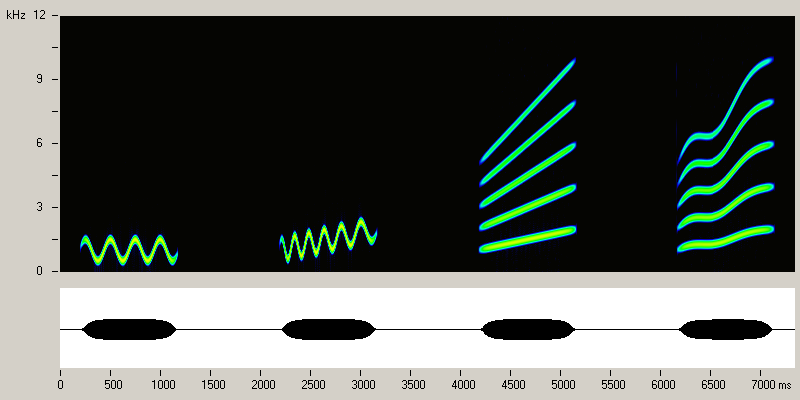
Università degli Studi di Pavia
Centro Interdisciplinare di Bioacustica e Ricerche Ambientali
Via Taramelli 24 - 27100 Pavia - Italyemail : cibra@unipv.it
Spectrogram
To analyze sounds it is required to have an acoustic receiver (a microphone, an hydrophone or a vibration transducer) and an analyzer suitable for the frequencies of the signals we want to measure. Eventually, a recorder may allow to permanently store the sounds to allow later analyses or playbacks.
A spectrograph transforms sounds into images to make "visible", and thus measurable and comparable, sound features the human hear can't perceive. Spectrograms (also called sonograms or sonagrams) may show infrasounds, like those emitted by some large whales or by elephants, as well as ultrasounds, like those emitted by echolocating dolphins and by echolocating bats, but also emitted by insects and small rodents.
Spectrograms may reveal features, like fast frequency or amplitude modulations we can't hear even if they lie within our hearing frequency limits (30 Hz - 16 kHz). Spectrograms are widely used to show the features of animal voices, of the human voice and also of machinery noise.
A real-time spectrograph displays continuously the results of the analyses on the incoming sounds with a very small - often not perceivable - delay. This kind of instrumentation is very useful in field research because it allows to continuously monitor the sounds received by the sensors, to immediately evaluate their features, and to classify the received signals. A spectrograph can be dedicated instrument or a normal computer equipped with suitable hardware for receiving and digitizing sounds and a software to analyze sounds and convert them into a graphical representation.
Normally, a spectrogram represents the time on the x axis, frequency on the y axis and the amplitude of the signals by using a scale of grays or a scale of colours. In some applications, in particular those related with military uses, the x and y axes are swapped.
The quality and features of a spectrogram
are controlled by a set of parameters. A default set can
be used for generic display, but some parameters can be
changed to optimize the display of specific features of
the signals.
Also, by modifying the colour scale it is possible to
optimize the display of the amplitude range of interest.
All spectrograms shown on the this website have been made with software developed by CIBRA. Some have been made many years ago with DOS software such us the Duetto and the SBRTA programs. The most recent spectrograms on marine mammals voices have been made with SeaPro (formerly called wSpecGram). To know more about these programs visit the pages on hardware and software developed by CIBRA.
How a sound appears on a spectrogram ?
A tone at a costant frequency will appear
as an horizontal line with its vertical position depending
on the frequency of the tone. A tone with increasing
frequency will appear as an inclined line, while a
modulated tone will be represented by a line moving up and
down on the display.
On the contrary, an impulse is a very short event with
energy at all frequencies and thus it will appear as a
vertical line located at a certain time.
A third type of sound is the "noise". The concept of noise
may be ambiguous and thus it requires some clarification.
In common use, noise means something disturbing. People
working with military sonars used to call "biological
noise" the sounds emitted by marine mammals and by other
vocalizing animals like fishes and crustaceans. On the
contrary, biologists consider "noise" all sounds emitted
by machineries like propellers and engines.
In technical terms, noise is an acoustic event with a
chaotic or random structure. The ideal noise is the so
called "white noise", a signal covering the whole audible
spectrum. In a more general use, it is considered noise a
signal composed by a wide range of frequencies with a
random structure.
Considering these aspects, it is thus important to provide
a definition each time the term "noise" is used.
Of course in the real worlds things may be more complex than described, and the settings used to make a spectrogram may severely affects the image produced and the structures shown. For example, a series of pulses repeated at very short intervals may appear as a tonal sound or a series of pulses depending on the chosen time resolution. If the time resolution is greater than the pulse intervals, the spectrogram will be unable to resolve and separate the pulses and thus it will show artifacts.

Here a series of tones 1 second long. By looking at the envelope they seem all equal. By looking at the spectrogram we discover that the first is a tone at a constant freqeuncy at1kH, the second at 1.5 kHz, the third at 2 kHz. The last one is a up-sweep from 1 kHz to 2 kHz.

Here again four notes with the same envelope and duration but very different time-spectral features. The first is a frequency modulated tone with frequency 1 kHz modulated +&- 500 Hz with a modulation frequency of 4 Hz. The second is a tone with increasing modulated frequency; in this case the modulation frequency is not constant. The third note is a up-sweep with harmonic structure; the lowest trace is the fundamental frequency sweeping from 1 kHz to 2 kHz; above the fundamental we see 4 harmonics, the 2nd, the 3rd, the 4th and the 5fth harmonic. The fourth tone is a frequency modulated harmonic tone. At each time the harmonics have frequency that is an integer multiple of the fundamental.
![]() Other examples will
come soon!
Other examples will
come soon!
Created June 2005, updated November 2006